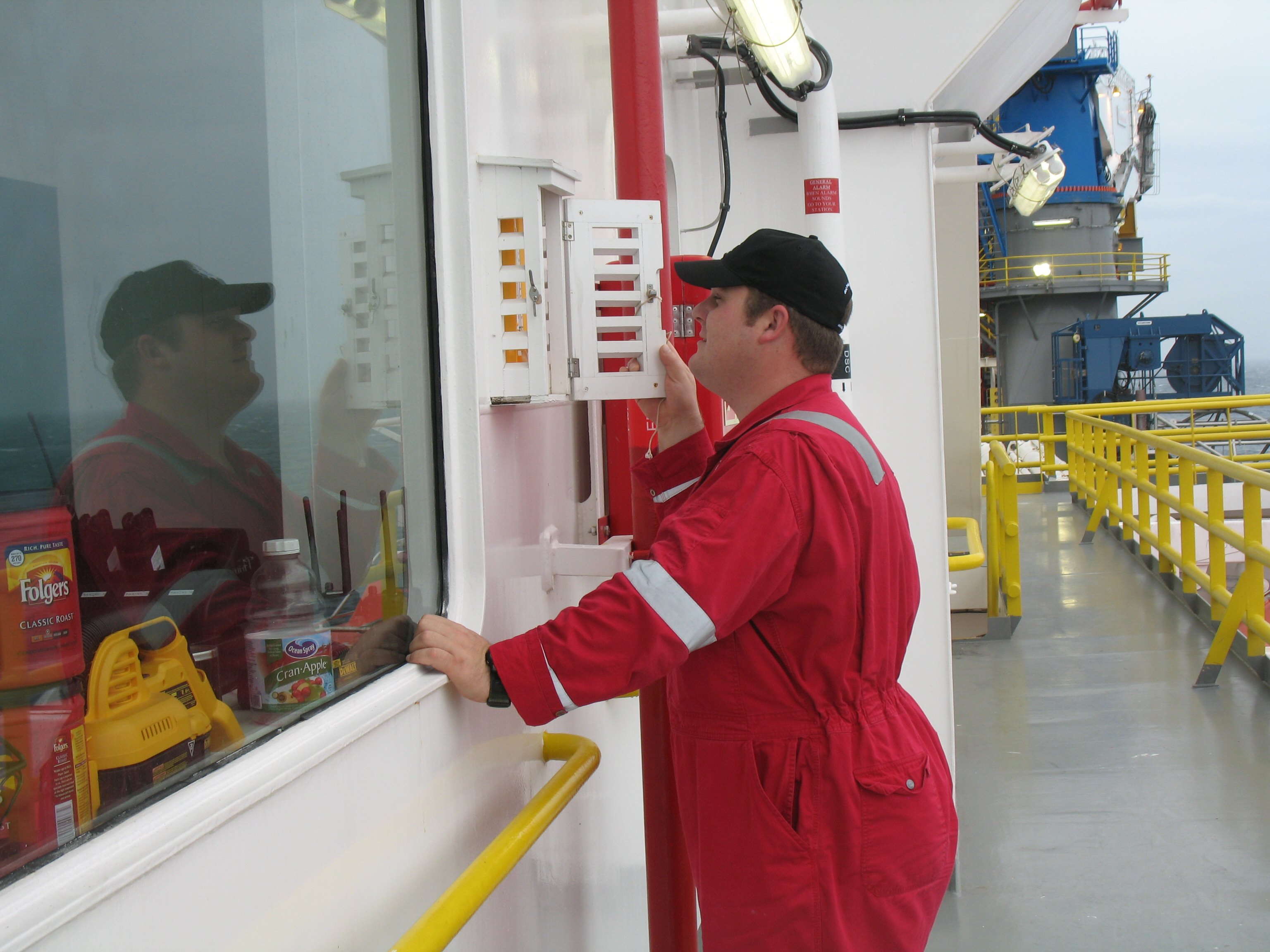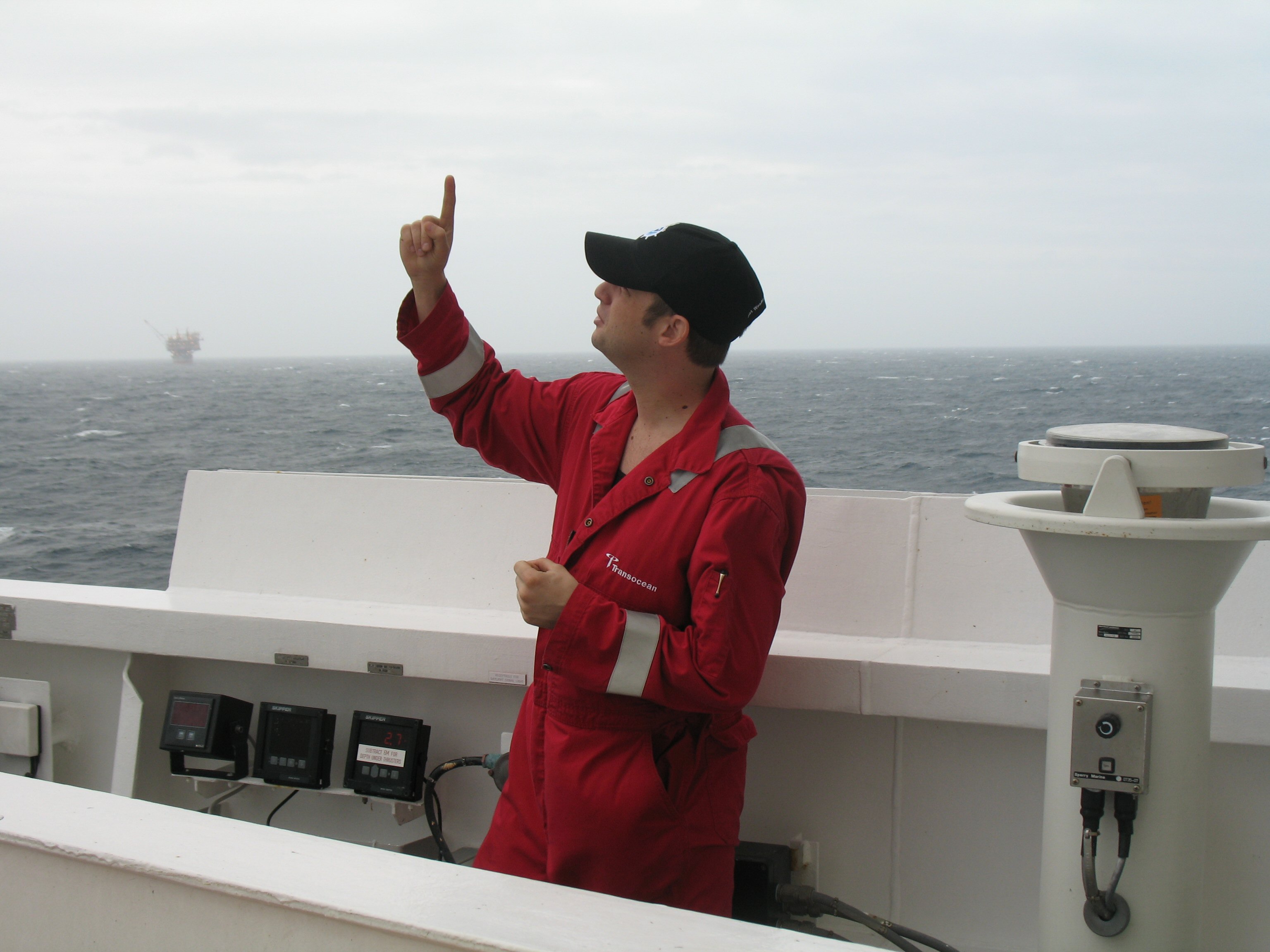Discoverer Clear Leader

Jean Cortez checking temps
Introduction
With environmental issues and concerns becoming frontline around the globe, it is no wonder why Transocean has become one of the most recognized companies for tasking their employees to embrace an active stewardship to our planet. In keeping true to this idea, many of the drill ships and platforms within Transocean have become an active voluntary participant of one of the most important grass roots program within NOAA’s National Weather Service, the Voluntary Observing Ship Program (VOS). With the growing concerns to climate change and global warming, now more than ever, there is an insatiable need for real-time environmental data. Increasing the quantity and quality of timely environmental data is the only way that NOAA and scientists/agencies around the world can engage in a unified effort towards healing and protecting our planet. Transocean seems to understand this by mandating environmental friendly initiatives in an effort to leave a smaller carbon footprint as well as becoming part of the overall solution. Environmental data that is provided by ships such as the DISCOVERER CLEAR LEADER will provide essential input for not only marine weather forecasts but for the purposes of forecasting the oceanic components of climate variability; facilitating safe and efficient marine operations; managing resources for sustainable use; preserving and restoring healthy marine ecosystems, and mitigating natural hazards.
In light of the most recent disaster, the explosion of the Deepwater Horizon which resulted in several deaths as well as the currently uncontained oil spill, Transocean is supporting BP, the MMS and the Unified Command in the containment efforts. Transocean was contacted soon after the disaster and they provided a list of the ships and platforms under Transocean located within Gulf of Mexico that were not currently participating in the U.S. VOS Program. Transocean proceeded to contact each and every one of these ships in an effort to get them actively producing marine weather observations in hourly and/or three hourly interval to assist in every facet of the oil spill recover/cleanup/forecast efforts. Also contacted were the individuals who work on these rigs owned by Transocean who would be responsible for producing the marine weather observations. It was evident from the emails and phone conversations among these units that there was a willingness to help without any hesitation. Obviously this article was written prior to this disaster, but the underlying theme remains true; Transocean has trained their employees to embrace an active stewardship to our planet.
This article is spotlighting one of Transocean’s newest deepwater drill ships that has recently become operational within the Gulf of Mexico, the DISCOVERER CLEAR LEADER. This ship has recently not only become fully operational in its mission for Chevron, but it is one of the newest recruits in the National Weather Service’s VOS program within the Transocean fleet. The vessels masters, Doug Banfield and John Anderson are exceptional in their enthusiasm for their crew to participate and provide NOAA with timely, accurate and abundant marine weather observations.

Adam Streeper checking the wind direction
Doug Banfield is no stranger to the VOS program. Although his ship is new, Doug is a veteran when it comes to participating in the VOS Program. Doug was previously attached to the deepwater drill ship DISCOVERER DEEP SEAS, the top weather observing drill ship in the fleet. Both Doug Banfield and Mike Galati (currently the Master of the DISCOVERER DEEP SEAS) have been participating in VOS for quite some time and I have had the pleasure of working with them since 2004. When Doug transferred from the DISCOVERER DEEP SEAS to the newly built CLEAR LEADER, Doug’s commitment to the VOS program remained strong and unwavering. At first chance, he took the initiative to get the CLEAR LEADER, recruited into VOS by contacting me in early 2009 before his ships construction was completed. Start up materials as well as the SEAS (Shipboard Environmental Acquisition System) software were sent to the ship in order for the crew to familiarize themselves before becoming an active VOS participant. As with anything new, it took a few months to get things in order and get a good flow of data going but in a matter of a few months, the DISCOVERER CLEAR LEADER began sending out monthly totals of marine weather observations that would rival its top performing sister ship, DISCOVERER DEEP SEAS. There is a strong sense of friendly competition evident between these two ships and this will be ongoing for quite some time! Competition within a fleet is very common and creates good fun and a sense of camaraderie amongst the crews.
Early in February, I was able to fly out via helicopter to the DISCOVERER CLEAR LEADER for a VOS visit. Not only was this visit an opportunity to adjust the aneroid barometer, update their software and to complete any other standard VOS task needed, but to get face time with most of the men and women who are responsible for taking marine weather observations and may have some questions on observing techniques. This is the time when and if a particular drill ship receives a VOS award for outstanding performance; I will present it to the Master and crew and have the photo opportunity for posting in our quarterly circulation, The Mariners Weather Log. We get to talk about families, future career plans, transfers to different ships within the fleet and pending promotions. Some of us play catch-up since our last visit, whether it was on the same ship or one of the other ships and they had a transfer. This is a chance for a more personable bearing in this business of data collection. After all, you have to remember that this is strictly a voluntary service that ships and their crews are supplying to NOAA. This invaluable service needs to reciprocated in some form or fashion, and what an enjoyable responsibility to fulfill that obligation by being invited to visit such a wonderful bunch of individuals and to be able to spend time with them. I truly got the VIP treatment while on the CLEAR LEADER. I was given the grand tour of the ship by 2nd Mate Adam Streeper, one of the most enthusiastic persons I have ever met. I got to see everything from the moon pool to the engine room. Adam was able to arrange for me to take the elevator to the top of the drill ship’s derrick. Pictures just don’t do this ship justice, they work with items on such a large scale and every job on the ship is absolutely critical. On the bridge of the DISCOVERER CLEAR LEADER another critical responsibility is held fast, and that is the scheduled and unscheduled transmission of marine weather observations. Routinely, ships transmit marine weather observations every six hours. The CLEAR LEADER transmits on a three hourly schedule and at times when weather is critical, hourly. It is estimated from its 2009performance that the DISCOVERER CLEAR LEADER will provide over 1,500 marine weather observations in 2010.
More new additions to the fleet will further enhance NOAA’s coverage for environmental interests and impacts; the DISCOVERER AMERICAS and the DISCOVERER INSPIRATION are just two new ships of many that will service not only Transocean, but NOAA’s National Weather Service as well as the Voluntary Observing Ship Program. VOS looks forward to working with these ships and knows that the friendly rivalry between thee crews will not only help with the VOS and NOAA’s mission, but also aid in a better and healthier planet for us all.
Back to top
